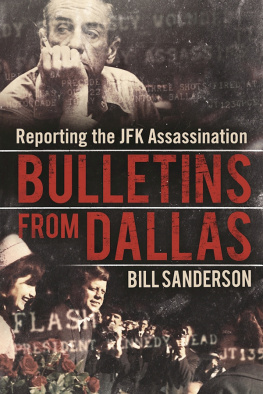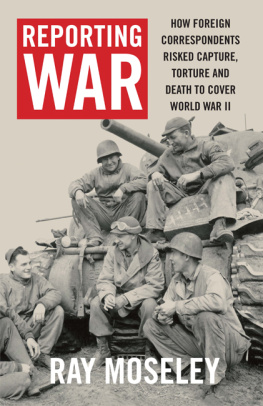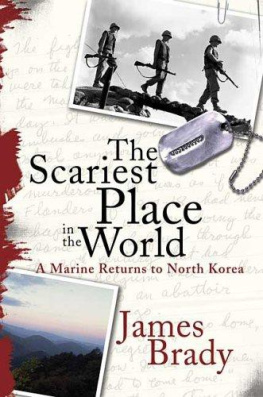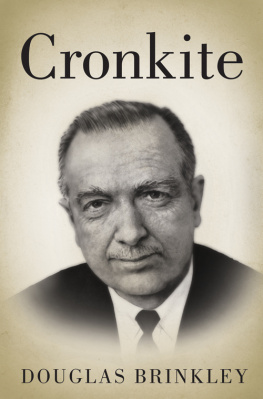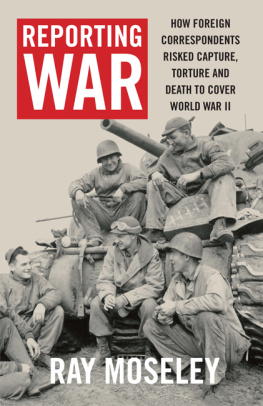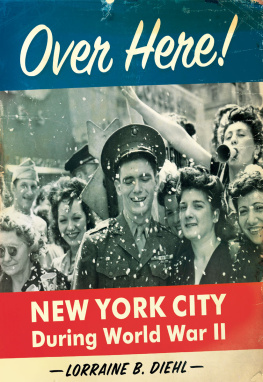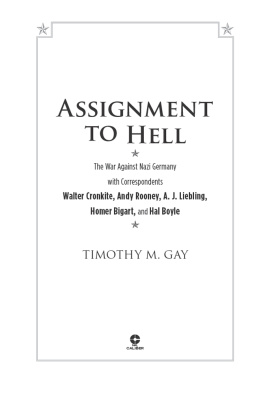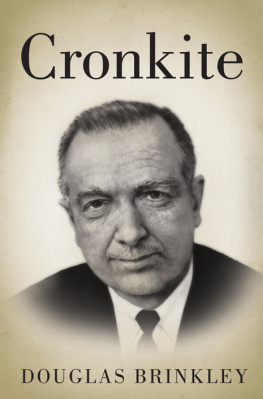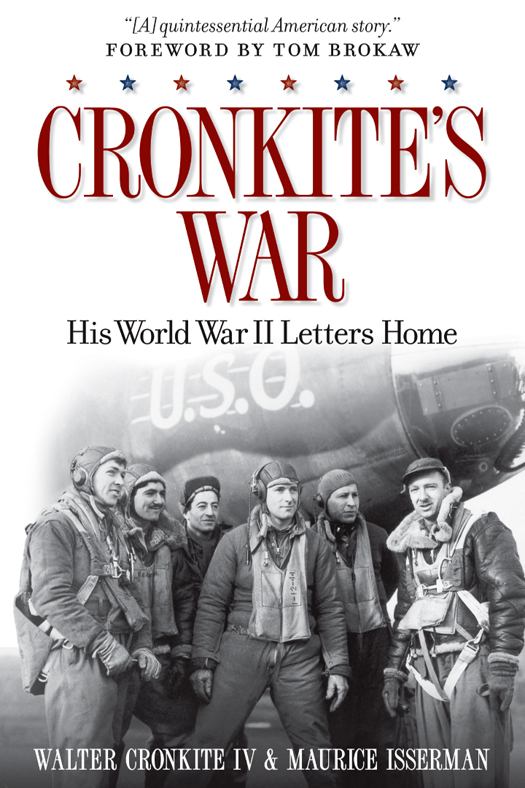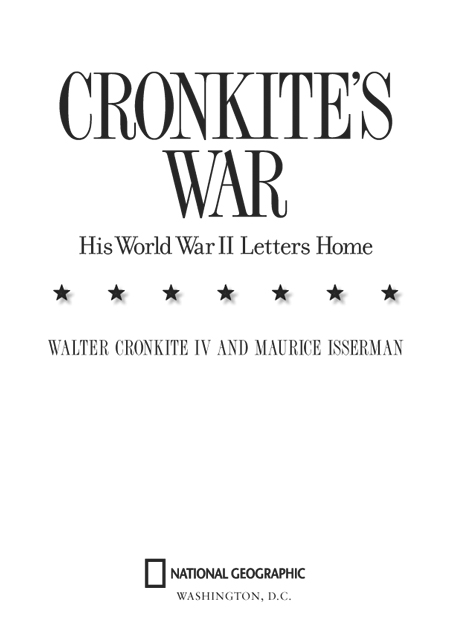Published by the National Geographic Society
1145 17th Street N.W., Washington, D.C. 20036-4688 U.S.A.
Copyright 2013 by Walter Cronkite IV and Maurice Isserman. All rights reserved. Reproduction of the whole or any part of the contents without written permission from the publisher is prohibited.
Walter Cronkites United Press (UP) text excerpts courtesy United Press International (UPI).
eISBN: 978-1-4262-1020-4
Library of Congress Cataloging-in-Publication Data
Cronkite, Walter.
Cronkites war : his World War II letters home / Walter Cronkite IV and Maurice Isserman.
pages cm
Includes bibliographical references.
1. Cronkite, Walter--Correspondence. 2. Cronkite, Walter--Family. 3. Cronkite, Betsy, -2005--Correspondence. 4. World War, 1939-1945--Journalists--Correspondence. 5. War correspondents--United States--Correspondence. 6. World War, 1939-1945--Aerial operations, American. 7. World War, 1939-1945--Campaigns--Europe. 8. World War, 1939-1945--England--London-Anecdotes. 9. United Press International--Biography. 10. World War, 1939-1945--Personal narratives. 11. Love-letters--United States. I. Isserman, Maurice. II. Cronkite, Walter, IV. III. Title.
D799.U6C76 2012
070.44994053092--dc23
2012045334
The National Geographic Society is one of the worlds largest private nonprofit scientific and educational organizations. Founded in 1888 to increase and diffuse geographic knowledge, the Societys mission is to inspire people to care about the planet. It reaches more than 400 million people worldwide each month through its official journal, National Geographic, and other magazines; National Geographic Channel; television documentaries; music; radio; films; books; DVDs; maps; exhibitions; live events; school publishing programs; interactive media; and merchandise. National Geographic has funded more than 10,000 scientific research, conservation, and exploration projects and supports an education program promoting geographic literacy.
For more information, visit www.nationalgeographic.com.
National Geographic Society
1145 17th Street N.W.
Washington, D.C. 20036-4688 U.S.A.
For information about special discounts for bulk purchases, please contact
National Geographic Books Special Sales:
For rights or permissions inquiries, please contact National Geographic Books Subsidiary Rights:
Interior design: Katie Olsen
v3.1
For Betsy Cronkitemy beloved grandmother.
Walter Cronkite IV
For Walter Cronkite, Jr.anchorman, CBS Evening News, 19621981who reported the world to me.
Maurice Isserman
CONTENTS
A UTHORS N OTE
The letters in this book have been edited by the authors for improved readability, but no text has been changed.
FOREWORD
B y the end of the 20th century, Walter Cronkite was one of the most famous Americans of his time. He carried the coveted title the Most Trusted Man in America, and to generations of younger viewers, he was known as Uncle Walter, the steady and wise man guiding the country through so much tumultuous change from his anchor desk on CBS Evening News.
To those of us who shared his profession, he was a role model as a journalist and also as a family man, a father and the husband of the incomparable Betsy, a winsome woman he met in the early stages of his career in Kansas City. To their many friends (and I was proud to be in that company), they were simply Walter and Betsy, a matched pair with a zest for lifewhether it was a sailing vacation, an opening night on Broadway, box seats at the Kentucky Derby, or at a sing-along after a dinner party.
Their sense of adventure started early, for they were married in 1940, on the cusp of World War II, when the future of the free world was to be determined in what some military historians have called the greatest single event in the history of mankind.
By 1942 Walter was headed for that war as a correspondent for the United Press. The next year he was based in London and covering the war on a daily basis, primarily by reporting on the dangerous bombing missions of the Eighth Air Force.
London, that most elegant of cities, was on a full-time war footing, blacked out at night to discourage German air strikes, living on reduced rations, and trying to accommodate the crush of newcomers who poured into the British capital to launch the counterattack against Nazi Germany.
In this remarkable collection of personal letters from Walter to Betsy, the reader is transported back to the pivotal years of 194345, when the push against Hitlers war machine was beginning to have its effect. Betsy was back in New York with their beloved cocker spaniel, Judy, for what would prove to be a long separation.
In the straight-ahead, honest prose he later became famous for as an anchorman, Walter mixed the momentous, the personal, and the ordinary in his dispatches to Betsy, worrying about how to make his meager salary cover room, meals, and wardrobe. War correspondents in those days wore special uniforms, which they had to purchase, and they drew rations such as one big Tootsie Roll, vanilla wafers, cheese niblets, a carton of cigarettes, and a box of razor blades. At one point he let her know that his share of a room was $18 a week, explaining that the price may seem exorbitant (!) but that space was scarce.
Walters days and nights were long and irregular, and he often told Betsy of his exhaustion, brought on by working through the night to hammer out an account of a bombing raid and then to get it through the censors and onto the wires for transmission to the United Press (UP) newspaper clients in the U.S.
It wasnt all work and no play, however. Walter came to be a drinking pal with Clark Gable, the big Hollywood star who had enlisted and flew combat missions with the Eighth Air Force. He began a lifelong friendship with Andy Rooney, and his UP boss was Harrison Salisbury, a legendary journalist for my generation. A bar was always open somewhere, and its plain that Uncle Walter enjoyed a nightcap.
His most famous assignment that year was also the most dangerous. The gifted young men who covered the Eighth Air Force persuaded Army brass that they should be able to accompany a bombing mission over Germany. Remember, this was at a time when casualty rates were high because the bombers didnt have adequate close-air support and the German homeland was laced with air defense weapons. Cronkite flew in the Plexiglas nose cone of a B-17 during the raid and later admitted that he manned the .50-caliber machine gun against German fighter planes when they were attacked over the target. His bomber made it back safely, but a plane carrying a New York Times reporter was shot down and his body never was recovered.
Cronkites first-person account of the raidthe first ever written by a journalist along for the ridereceived wide play and high praise across the United States, but in his letters to Betsy he remained characteristically matter-of-fact in describing the stack of congratulatory messages he received.


